April 10th is Gopher Tortoise Day!
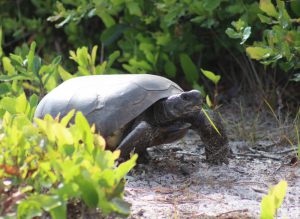
Photo credit: K. Clements
On any given day in the scrub, gopher tortoises may be seen out and about, looking for lunch or basking in the sun. The scrub ecosystem is a rare component of our Florida environment and is home to many wonderful plants and animals. Tortoises are a type of turtle, but unlike sea turtles or freshwater turtles, tortoises are terrestrial, or spend their life on land. Gopher tortoises are the only tortoise species east of the Mississippi and are found throughout much of Florida, south Georgia, and southern portions of South Carolina, Alabama, Mississippi, and Louisiana.
Gopher tortoise (Gopherus polyphemus)

Photo credit: K. Clements
Gopher tortoises have a dark grey or brownish domed shell, often peppered with the sand from their very own burrow. They have a strong, sharp beak-like mouth that is adapted for eating their favorite foods like native grasses, gopher apple, and prickly pear cactus.
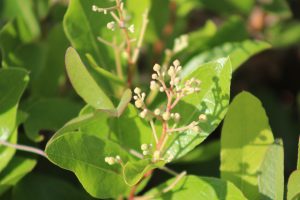
They have short, stubby legs with shovel-like front feet that are the perfect tools for digging in the sand. Young gopher tortoises are about 1.7 inches when they hatch, and their shell is more yellow. Their shells stay soft for up to 7 years. Adult gopher tortoises average 10 inches in diameter and live to be 40-60 years old!
Wild, wonderful, and wacky
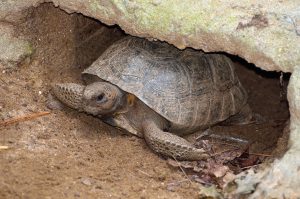
Image by Paul Brennan from Pixabay.
Scutes: Gopher tortoises are reptiles, like snakes and lizards and alligators. Snakes shed their skin as they grow, but a tortoise’s spine is attached to their upper shell, called a carapace. As they grow, their shell must grow with them. A gopher tortoise shell is actually made up of numerous plates, called scutes, made of keratin, the same substance our fingernails are made from. As a tortoise grows, new larger scutes are formed under the older scutes which are then shed. On some tortoises (and turtles) you can count the rings on their scutes to estimate their age!
Gular horn: How do you tell a male tortoise from a female tortoise? Male tortoises and turtles have a gular horn. This is an elongated portion of the front of the plastron, or bottom shell. Males use their gular horns to fight over territory or female tortoises. Male tortoises also have a concave plastron, females have a flat plastron. But don’t pick up a gopher tortoise to look at their shell! They’re protected by law!

Keystone species: Like the necessary top stone that holds up the arch of a bridge, a keystone species is necessary to its ecosystem. Keystone species, like gopher tortoises, often determine the health of their ecosystem and the other species that live there. Research has shown that over 350 different species of animals rely on the gopher tortoise and its burrow. The burrow can be 6.5 feet deep, and on average 16 feet long, although some burrows can be up to 45 feet long. Burrows have only one opening, but a tortoise may use more than one burrow at a time. Burrows remain about the same temperature and humidity throughout the year, providing respite from the heat of summer and the coolness of winter.
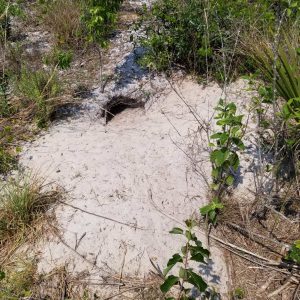
Photo credit: K. Clements
Burrows are also a refuge from fires that burn through the scrub helping regenerate native plants, restore nutrients to sandy soil, and clear patches of open ground for gopher tortoise travel and Florida scrub jays to cache their acorns. The endangered indigo snake and gopher frog, gopher mouse, rabbits, racerunners and skinks at any given moment may be using the gopher tortoise burrow to shelter from the weather, lay eggs, hide from predators, or stay safe from a fire. If gopher tortoise populations decline, many other animal populations will be negatively affected.
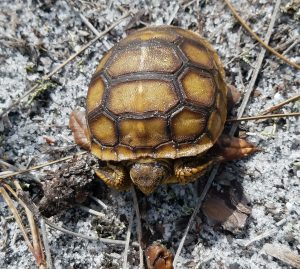
Photo credit: K. Clements
Apron: This is the loose sandy soil at the door of the burrow that has been dug out by the tortoise. Often the apron is oriented in the direction that receives the most sun and becomes the perfect place for the mother tortoise to lay her eggs. It can take a female tortoise 10-20 years to reach maturity and she only lays an average of 6-8 eggs once a year in the summer. Protect our gopher tortoise populations, never walk on the apron!
Threats to the Gopher Tortoise
Habitat destruction is the greatest threat to the continuation of the gopher tortoise. They prefer high, dry, sandy land to dig their burrows. This is often the type of land that is chosen for development, mining, citrus and pine plantations. Fire suppression and invasive plants change habitats so that they do not provide the components necessary for the survival of the tortoise. Tortoises are also susceptible to upper respiratory tract disease (URTD). The gopher tortoises’ only real predators are humans and dogs, so keep your dogs leashed and watch out for our tortoises on the roads or in your neighborhood!
Keeping gopher tortoises safe
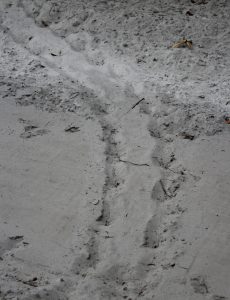
Photo credit: K. Clements
Gopher tortoises in Florida are listed as threatened under the Endangered Species Act. Permits are required for the relocation of tortoises. Tortoises can be relocated to FWC approved recipient sites. Normal activities that do not disturb tortoises or their burrow do not require a permit, but keep dogs away from tortoises and their burrows. You may help tortoises across a roadway (in the direction they were traveling), but otherwise do not handle or harass a tortoise in any way. Stress in animals can affect their behavior, feeding and reproductive habits. Planting native grasses and gopher tortoise friendly plants is a great way to landscape your yard and help provide habitat for these wonderful animals! Read more about how you can help tortoises in your backyard, on the roads, or if one is injured HERE.
- Are there ways that sea turtles and gopher tortoises are alike? How are they different?
- Gopher tortoises have other interesting adaptations, do you know what these words mean? Ectothermic? Vomeronasal organ?
- Want to pretend to be a gopher tortoise for a day and make a burrow? Build-a-Burrow Instructions from the FWC will show you how. Who will you invite to share your burrow?
For more information on gopher tortoises click here. For information on their conservation plan and how you can help, visit the Florida Fish and Wildlife Conservation Commission. For printable brochures, posters, and coloring sheets visit https://myfwc.com/education/wildlife/gopher-tortoise/.
Read all our Wild Sarasota blogs HERE
 1
1

